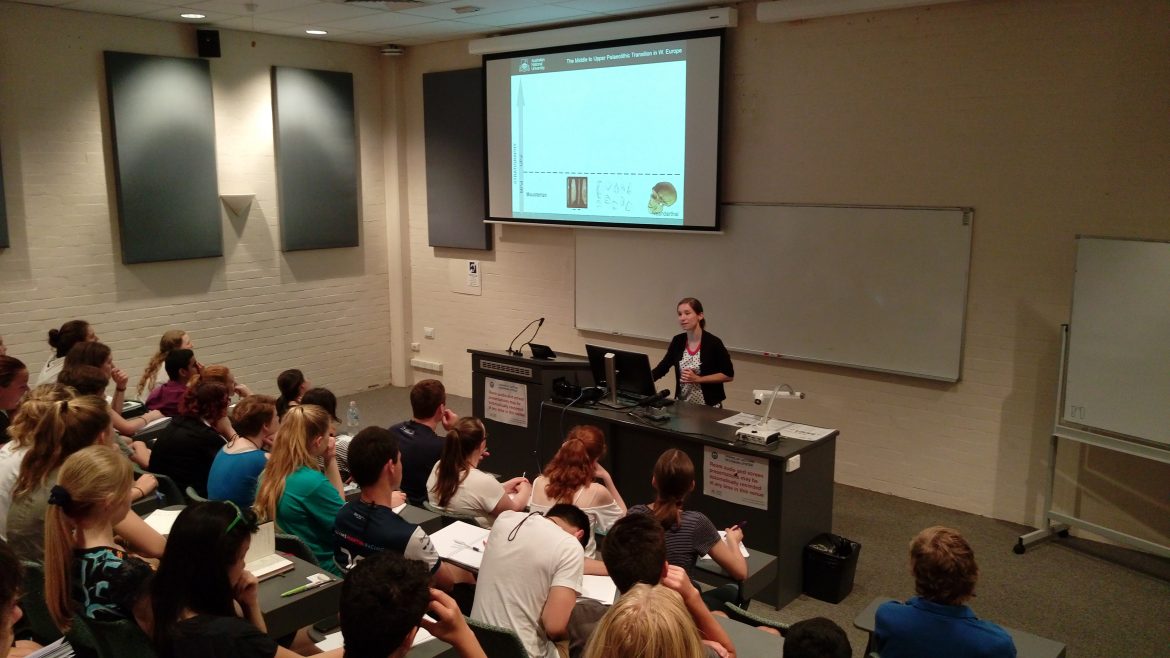“It’s time to solve old mysteries.”
This year, NYSF 2017 participants were able to attend one of three specialist lectures which catered to their personal interests in STEM. Students with an interest in anthropology and biology attended a lecture presented by Dr Rachel Wood. Dr Wood completed her master’s degree in archaeological science at the University of Oxford, she then worked at the Salisbury Museum before returning to Oxford to complete a PhD in radiocarbon dating. In 2011 Dr Wood moved to the ANU as part of a research offer, before joining the ANU as a post-doctoral fellow in 2015.
Dr Rachel Wood is a paleoanthropologist, which is the study of the formation and development of characteristics possessed by modern humans. “It’s time to solve old mysteries,” said Dr Wood. She is dedicated to studying the dispersal of humans and the last Neanderthals. Palaeoanthropology is a mixing pot that combines nuclear physics, engineering, anthropology, chemistry and biology into one discipline, which means that palaeoanthropology projects require a team of scientists with a diverse range of skills.
Homo Neanderthalensis (Neanderthals) originated in Eurasia approximately 300,000 years ago, Dr Wood explained, and Homo Sapiens originated in Africa approximately 200,000 years ago. “Neanderthals aren’t brutes, they weren’t savages,” Dr Wood said in regards to the common portrayal of Neanderthals. Dr Wood explained that genetic research showed that modern humans and Neanderthals interbreeded, and that approximately 2% of the DNA of modern humans comes directly from Neanderthals.

Dr Rachel Wood speaking about biological samples from Neanderthals
There are many methods of dating archaeological samples, but radiocarbon dating is the most accepted. Carbon isotopes with six (12C) or seven (13C) neutrons are stable, that is, they don’t decay into any other atom. The carbon isotope with eight neutrons (14C) decays slowly, at a rate such that after 5,730 years, half of the carbon would have turned into nitrogen. Therefore, by measuring the amount of 14C in bone samples, paleoanthropologists can accurately determine the age of the samples. Due to the timescale of 14C decay, radiocarbon dating only works reliably for samples that are less than 50,000 years old.
Dr Wood focuses on cleaning and pretreating samples before they are dated. “Contamination often causes older samples to appear erroneously young,” Dr Wood explained, which is why effective management of samples prior to radiocarbon dating is imperative.
Spain is an area of interest for Dr Wood, because it is a region where modern humans and Neanderthals appeared to live next door to each other approximately forty to fifty thousand years ago. Detailed investigations have determined that there was likely an overlap period of 2500 to 4600 years where modern humans and Neanderthals coexisted in the region.
To find out more about Dr Rachel Wood and her research, click here.
By Daniel Lawson, NYSF 2017 Session A Communications Intern and NYSF 2015 Alumnus.